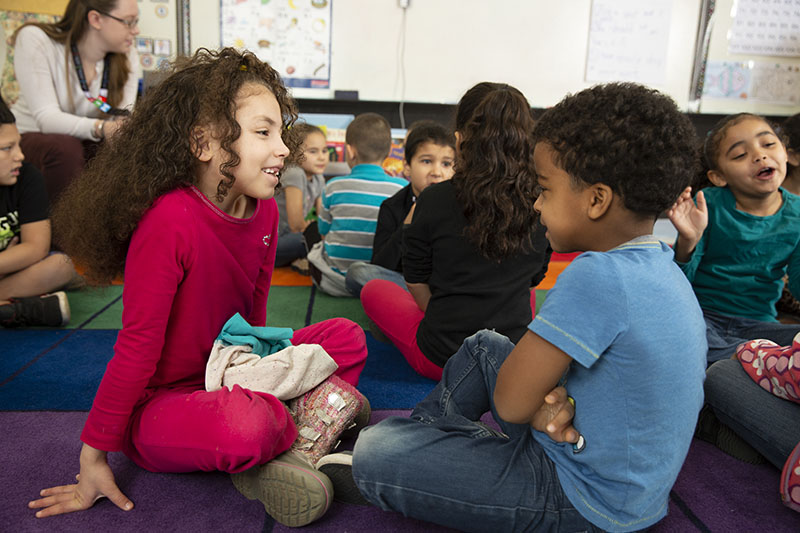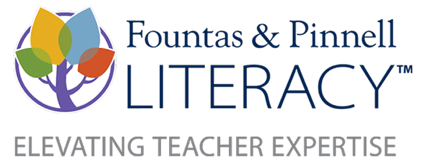
Welcome to A Look Inside Fountas & Pinnell Classroom™––a podcast series by educators for educators. Throughout the series we’ll be joined by educators, in conversation with the Heinemann team, who share inspiration and reflection as together we explore important, timely and practical topics centered around the implementation of FPC.
In Episode 2: "Fostering Talk Within a Community of Learners", listen in with Jess, a former teacher and literacy coach with first-hand experience implementing Fountas & Pinnell Classroom™. Our conversation centered around the importance of student talk and opportunities to foster thoughtful talk within a community of learners. Language infuses the reading and writing students do every day in the classroom. As children link their daily lives to their learning, they develop a richer understanding of themselves and their world, as well as a voice to talk about it.
Stay tuned for future episodes of A Look Inside Fountas & Pinnell Classroom™. Upcoming episodes will feature practical tips, stories from inside the classroom, and expert advice on topics that help us all lean into our practice and celebrate the teaching and learning we do every day.
“Your work as a teacher of literacy is worthwhile and important because it transforms the lives of children.”
– Irene Fountas and Gay Su Pinnell
Below is a full transcript of this episode.
Sam:
Welcome to A Look Inside Fountas & Pinnell Classroom™, a Heinemann podcast series by educators for educators. Throughout this series, we'll be joined by teachers, coaches and school leaders in conversation with the Heinemann team who share inspiration and reflection as together we explore important, timely and practical topics centered around the implementation of FPC. If you are tuning in for the first time, we invite you to listen in on our preview episode.
Sam:
In a lively and inclusive classroom community, students are reading, thinking about, writing about and talking about a wide range of beautiful, engaging books. And their curiosity drives authentic inquiry that builds a deep understanding of their world. Language infuses the reading and writing students do every day in the classroom. As children link their daily lives to these ideas, they develop a richer understanding of themselves and their world, as well as a voice to talk about it.
Sam:
Hi everyone. I'm Sam from the Fountas & Pinnell Literacy™ team, and today we're talking about talk. I sat down with Jess, a former teacher, literacy coach, and now a member of the Heinemann team. We started our conversation around the importance of student talk and opportunities to foster thoughtful talk within a community of learners.
Jess:
So talk is everything. It's how we get to know each other. When we respond to text by talking, we really reveal what we care about to our community and we get to know ourselves better. And then by getting to know ourselves and each other better, we build a community of readers. The support of that community allows us to take risks. And then once kids feel like they are part of this literacy community, they're willing to use talk to share their understandings and their perspectives. And it's also how teachers position themselves in the classroom is either the sage on the stage, that source of all knowledge, or as the facilitator who supports the community was speaking and listening as everyone thinks together. So, there's really a big difference between those two roles. And the kids pick up very easily on our stance by listening to the ways that we talk to or at them, versus the ways we talk with them and listen to them and respond to them.
Sam:
That's so true, Jess. Talk about text is critical in a literacy rich classroom. Let's dive into this a little bit. Why is talk about text so important?
Jess:
Well, talk is really the foundation of literacy learning in so many ways. Readers use talk to make meaning from texts. So, I think people sometimes think about talk only as a product meaning, did the student produce the correct response or not. But the process of constructing a response is equally important.
Jess:
The act of talking is really an act of composition. So, when readers listen to someone read, they have all sorts of ideas floating around in their brains. And in order to share them through talk, they have to organize them to some degree. So, talk allow students to really communicate and refine their ideas and they incorporate the academic language into their responses as well. So that's really important.
Jess:
And then another reason amongst the millions that talk is so important is that learning is a social process. So, kids really construct their understandings by listening to each other's perspectives and building on each other's thinking.
Sam:
Yeah, I mean, talk really does reveal a child's thinking. Let's talk specifically about Fountas & Pinnell Classroom™. It's clear how important the role of talk is in the classroom. In fact, it's a major pillar of FPC. How does FPC specifically support talk in the classroom?
Jess:
Well, if we value talk, then we make space for it. That means making teacher talk more intentional and concise, so there's more time for students to talk together. And the lessons in FPC are designed to prioritize space for children's voices and thinking. If we think about reading as thinking within, beyond, and about texts, talk is one of the most effective ways that we communicate that thinking. And FPC supports teachers with effective language for demonstrating thinking, teacher prompts for eliciting thinking from students. The lessons support teachers with demonstrating to students language for sharing, thinking, and having conversations, like the turn and talk routine which is essential, or appropriate ways to respond to peers in book clubs. Also as teachers develop goals for talking about reading in their classroom, the lessons really helped them be mindful of the first language and cultures of all their students and the English learners in their classroom.
Sam:
Yeah, Jess, you talk a lot about that space and teachers giving students that space to talk and to reveal their thinking about books and to share their ideas with peers. So, I remember when I was in the classroom, turning and talking was so effective at giving students that space to share their thinking. Talk a little bit about your experience within the FPC lessons around turning and talking and really the power of the book clubs to give students that space to talk about books together.
Jess:
I mean, even when we don't mean to, we tend to fill up the classroom with our own voice. Teachers, I think all of us struggle with limiting our own talk and then leaving that space for kids. What's really great about a turn and talk is that first of all, you're taking away that dynamic of teacher, student, teacher, student, teacher, student in a conversation, and you're positioning the students as important members of the community who need to hear from each other. You're giving them a little structure, so they know that they have to, especially for the youngest kids in a classroom, knee to knee, eye to eye, really scaffolding the social experience of talk and then helping them value each other's thoughts and opinions. And that kind of translates to book clubs as well, where the teacher is over time stepping back and allowing kids to talk with each other, listen to each other, and just observing all that she has demonstrated during interactive read-aloud, during guided reading. It's a really great opportunity to step back, observe, see what they're taking on and then move in when needed.
Jess:
So it's a really wonderful structure and FPC has so many resources that really support the teacher taking the role of facilitator in book clubs. Whether it's minilessons that help kids develop those talk routines or it's the lesson cards that come with the book clubs that help you understand the most important parts of the text that you're reading so that you can bring that to students' attention.
Sam:
And talk happens in the air, right? So it can float away if we aren't intentional about the ways that we capture it as teachers. Talk a little bit about the ways that FPC supports teachers in observing and capturing the thinking that students are doing in revealing through their talk.
Jess:
Yeah, I mean, FPC provides really useful forms that help teachers kind of get systematic about listening and recording their observations. Really you want to make sure that you're capturing that anecdotal information and organizing it in a way that is meaningful to you so you can plan for teaching the next day in responsive ways. So the forms are really a great place to start. It's a habit of mine though. So even though the forms exist to support you, you actually have to use them. That's one of those things that I think all teachers are working on.
Jess:
What's really great though, and what makes FPC so different than a lot of other resources I've seen, is that there are sections in every lesson that really help teachers understand what it would sound like. Really what the content of the talk would be if the students are taking on the most important ideas from a text. Because listening isn't easy and the lessons really guide your thinking and help you listen effectively to the students every day.
Sam:
That space that you talked about, Jess, it really helps in creating an authenticity to the conversation. And not only in the classroom, but in the real world, the ability to have an authentic conversation with others is such an important life skill. What conversational routines, most of which of course require explicit teaching, are important to establish in that getting started period with FPC.
Jess:
So, wait time is so important. We all, whether we're really young or the teacher in the classroom can feel uncomfortable with wait time because silence can sometimes feel awkward and we all feel like we want to fill up the space. So waiting, giving whoever you're listening to a little space to––once again, back to space––a little room to get their thinking organized without just jumping in, how to show respect for each other's thinking even if you disagree, and even giving kids that permission to disagree. Some need that more than others. How to listen really attentively. What does that look like and feel like? What do you do with your body when you're listening attentively? How to look at the person who is talking, how to speak clearly, how to wait for your turn. Once again, also tricky. We all interrupt each other. It's natural, it's a sign of engagement in many ways, but we don't want to talk over each other.
Jess:
How do we build on each other's ideas? Especially with little kids, you'll hear things like, "She took my idea. That's what I was going to say." And they're a little bit irritated about that, where I think it's your role as the teacher to flip that and say, "Yeah, you agree. That's what we do. We build on each other's ideas. How can you add to that and provide more evidence?" Or, "What do you have to contribute that kind of expands the idea that your friend put out into our classroom?" I mean, these are really basic things that we take for granted. Kids don't come to us necessarily knowing how to do these things and truly we all need some practice with this. I really think if we kept some of these principles in mind, the world would be a better place.
Sam:
Before we close each episode in this series, let's wrap up with a practical tip or a bright spot, one of those “a-ha moments” from our own experience in the classroom. Jess, what have you found helpful or useful working with teachers and students in implementing FPC? What stands out to you?
Jess:
Well, kind of staying on this topic of talk, I think the Minilessons Books provide so much support to teachers around talk. But I think when you're establishing that community and that culture in your classroom, it's so important to get everyone on the same page so that we all can hold each other to these expectations for how we interact as a community of learners. And one of the ways that I've seen that's really practical is through using those anchor charts that are in the Minilessons Book and constructing them with students.
Jess:
So all of these talk routines that we've talked about today, having that conversation with students so that they have rationale for why they're so important, and then charting them, and then having it as a reference point, "Hey, we talked about this, we all agreed that this is how we want to interact with each other." So it just really serves as a reminder to keep that talk space really sacred and to really help reinforce how critical talk is, how important it is for our learning, how important it is to hear everyone's voice in the classroom.
Sam:
Thanks Jess for your time today and talking with me about talk, and thanks to all of you for joining us. Stay tuned for future episodes of A Look Inside Fountas & Pinnell Classroom™. Upcoming episodes will feature practical tips, stories from inside the classroom, and expert advice on topics that help us all lean into our practice and celebrate the teaching and learning we do every day.
~ The Fountas & Pinnell Literacy™ Team





